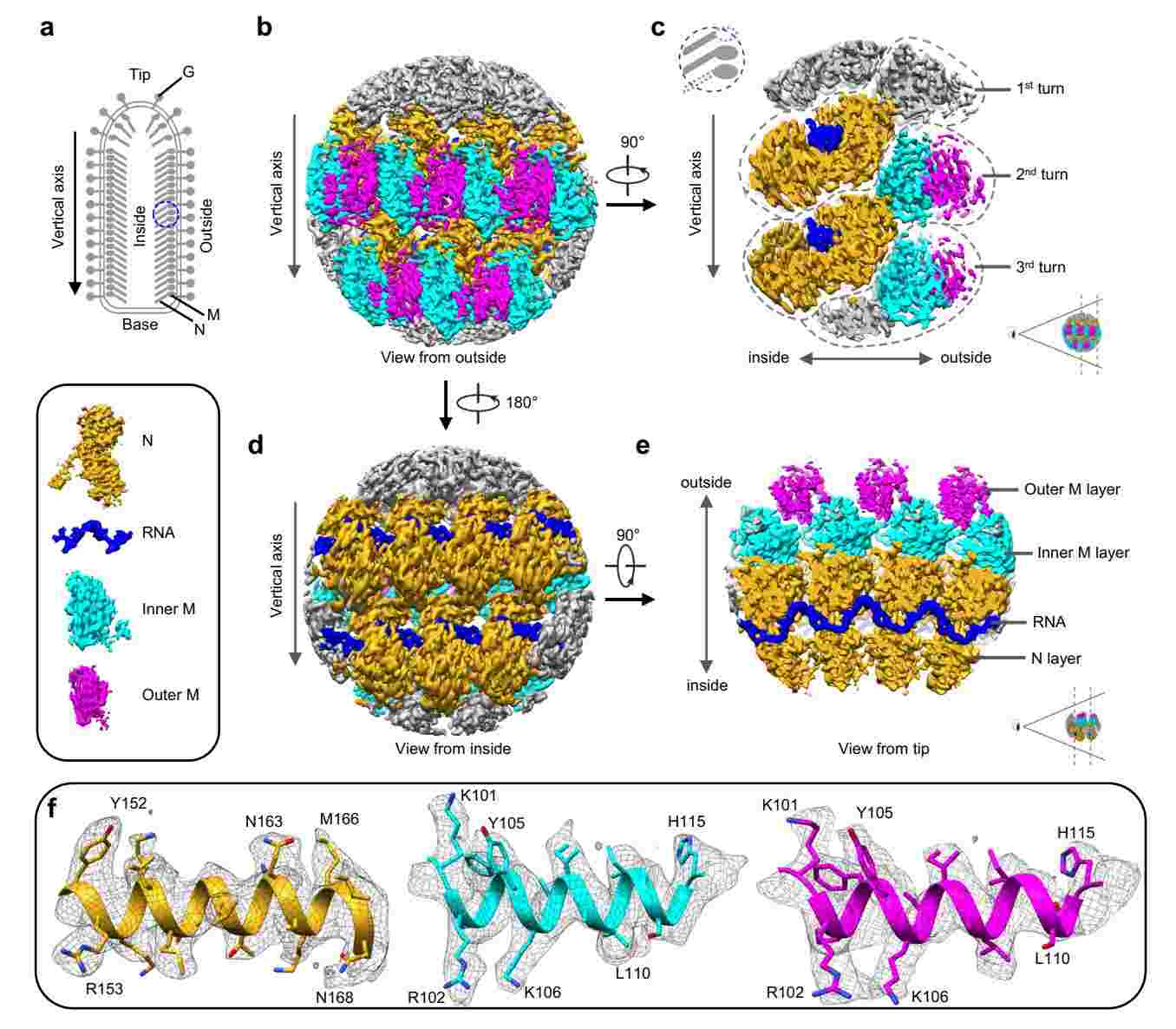Structural Research of Rhabdoviridae
Rhabdoviridae have a negative-sense, single-stranded RNA genome and consist primarily of enveloped, bullet-shaped, or rod-shaped viruses that can infect vertebrates, invertebrates, or plants. Most rhabdoviruses are transmitted to vertebrates or plants by arthropods, and the well-known rhabdoviruses include rabies virus (RABV) and vesicular stomatitis virus (VSV). Of these, RV is the leading cause of rabies in humans, with patients experiencing respiratory and swallowing difficulties and causing cardiovascular dysfunction or sudden death. In recent years, researchers have characterized rhabdoviruses to identify potential new drug targets against these RNA viruses through comprehensive structural analysis.
 Figure 1. Sub-particle reconstruction of VSV trunk at near-atomic resolution. (Zhou K, et al, 2022)
Figure 1. Sub-particle reconstruction of VSV trunk at near-atomic resolution. (Zhou K, et al, 2022)
Morphology of Rhabdoviruses Virus Particles
Animal rhabdoviruses have an overall bullet-like shape with a conical end and a flat end, whereas plant rhabdoviruses have a bacillus-like shape with two conical ends. The length of the viral particles, as observed by electron microscopy (EM), ranges from 100 to 430 nm, and the diameter ranges from 45 to 100 nm. The capsid is covered by a lipid envelope derived from the host cell membrane and exhibits helical symmetry with trimeric glycoprotein (G) spikes on the surface, which facilitates entry into the host cell by endocytosis. Research has found that the capsid contains the ribonucleoprotein complex (RNP), which contains genomic RNA closely related to the nucleoprotein (N). N-RNA binds to RNA-dependent RNA polymerase (L) and phosphoprotein (P). Between the envelope and the capsid is a tightly packed matrix protein (M) layer that interacts with transmembrane glycoproteins and RNP complexes in the capsid.
Advances in the Structural Research of Rhabdoviruses
In recent years, significant progress has been made in research on rhabdoviruses, shedding light on the molecular biology, pathogenesis, and potential interventions for these viruses. For example, the elucidation of the genomic organization, protein function and replication mechanisms of VSV and RABV has greatly enhanced the understanding of these viruses. One area of note is the characterization of rhabdovirus proteins and their interactions with the host. Structural research has provided valuable insights into the three-dimensional organization of critical viral proteins, including G responsible for viral entry, and L involved in replication and transcription. In recent years, researchers have determined the in-situ structures of the M and N of VSV at a resolution of 3.47 Å by cryo-electron microscopy (cryo-EM) and sub-particle reconstruction. Understanding the structural basis of these interactions could help in the design of inhibitors that target specific viral proteins, leading to the development of potential antiviral therapies.
Creative Biostructure specializes in virus structure research. We offer a wide range of elaborately designed virus-like particles (VLPs) products that can be used as valuable tools for research into virus morphology, immunology, and vaccine development. Our VLP products mimic the morphology and surface characteristics of viruses, providing a safe, infection-free alternative for researching viral structure.
| Cat No. | Product Name | Virus Name | Source | Composition |
| CBS-V578 | Chimeric EBOV & VSV VLP (VP40; G(VSV) Proteins) | Ebola virus; Vesicular stomatitis virus | Mammalian cell recombinant | VP40(EBOV); G(VSV) |
| CBS-V727 | Rabies virus VLP (G; M Proteins) | Rabies virus | Insect cell recombinant | G; M |
| Explore All Rhabdoviridae Virus-like Particle Products | ||||
With deep expertise and cutting-edge technology in viral structural biology, Creative Biostructure provides comprehensive viral structure analysis solutions to improve clients' understanding of viral structural biology and support basic research or antiviral drug and vaccine development.
Our highly skilled scientists are well versed in cutting-edge cryo-electron microscopy (cryo-EM) techniques to offer accurate and detailed high-resolution structural analyses of viral particles and virus-like particles, revealing complex structural and molecular interactions. If you have any questions, please feel free to contact us!
References
- Zhou K, et al. Atomic model of vesicular stomatitis virus and mechanism of assembly. Nat Commun. 2022. 13(1): 5980.
- Shepherd JG, et al. Emerging Rhabdoviruses and Human Infection. Biology. 2023. 12(6): 878.
- Dietzgen RG, et al. The family Rhabdoviridae: mono- and bipartite negative-sense RNA viruses with diverse genome organization and common evolutionary origins. Virus Res. 2017. 227: 158-170.
- Ivanov I, et al. Structural insights into the rhabdovirus transcription/replication complex. Virus Res. 2011. 162(1-2): 126-137.